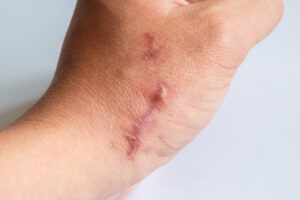Laser hair removal treatments are popular cosmetic procedures that most of the time go off without a hitch. However, when something does go wrong, there can be serious consequences for the health and financial wellbeing of those affected. So, we’ve made this guide on how to sue for laser hair removal burns.
We have undertaken a head-to-toe examination of the claims process, looking at who can make a claim and what evidence might be needed. We also explore what standards of care practitioners need to follow, some common causes of laser hair removal burns, and what factors can influence compensation payouts.
In our final section, we look at the No Win No Fee contract offered by our panel of solicitors and how you could benefit greatly when claiming under these terms.
Want to find out whether you are eligible to claim compensation? You can get a free eligibility assessment today by talking to our advisory team:
- Call us on 0800 408 7827.
- You can also contact us online by completing a callback form.
- Or, you can open the live chat window on your screen now.
Select A Section
- How To Sue For Laser Hair Removal Burns
- What Causes Burns From Laser Hair Removal?
- The Most Common Injuries Caused By Negligent Laser Hair Removal
- How Much Laser Hair Removal Burns Compensation Could I Get?
- Do I Have To Claim Within A Set Time Period?
- Get Free Advice From How To Sue’s Advisors
- Learn More
How To Sue For Laser Hair Removal Burns
When examining how to sue for laser hair removal burns, you need to be able to demonstrate that your practitioner owed you a duty of care and breached this in some way, causing you harm. A duty of care refers to a legal responsibility to take practical steps to ensure another’s safety and wellbeing.
While there is no law specifically governing beauty treatments, practitioners do need to have qualifications to perform laser treatments. Moreover, some practitioners who use class 3B/4 lasers or intense pulsed light (IPL) may have to register with the Care Quality Commission (CQC), an independent regulator for health care providers in England.
Additionally, the Occupiers’ Liability Act 1957 requires those in control of premises like a salon to use practical measures to keep visitors reasonably safe. Additionally, traders like laser hair removal practitioners must provide their services with reasonable skill and care. This expectation is set out by Part 1 of the Consumer Rights Act 2015.
With all that in mind, the eligibility criteria can be summarised as follows:
- You were owed a duty of care by your practitioner.
- The care you received fell below the expected standard.
- This breach of duty caused you avoidable harm.
“Avoidable harm” is any harm caused that would not have occurred if the correct standards had been met. For our guide, the avoidable harm in question is laser burns. We’ll examine some more specific scenarios in a later section.
What Evidence Will I Need To Support My Claim?
The evidence you will need to support your claim is very straightforward. We have set out a few examples here, and if you’re eligible to claim, a solicitor from our panel could help you gather the proof needed to strengthen your case.
Ways you can prove the duty of care was breached include:
- Medical records showing how you were treated for burns.
- A professional diagnosis of any related psychological injury.
- Photographs of burns, scarring, or other visible harm.
Would you like further guidance on what evidence your claim might need? Then, please reach out to our team today.
What Causes Burns From Laser Hair Removal?
The causes of burns from laser hair removal can vary. It is normal to experience some minor symptoms, such as redness, skin irritation, pigment changes, and low-level pain with laser treatment. These are all things that usually subside on their own within a few days.
What we’re going to look at is harm that should never have occurred. We’ve given a few examples of negligent treatment below:
- Your practitioner does not carry out a pain test before your treatment and uses a higher strength laser. Consequently, you suffer painful leg burns that permanently impair your mobility.
- You do not get sufficient guidance on appropriate aftercare following your procedure. As a result, your skin becomes cracked and very badly blistered, resulting in major discomfort as well as a significant psychological effect.
- A practitioner ignores their training and leaves the laser on your skin for too long, resulting in permanent scarring.
These are, of course, only a snapshot of how burns can be caused by negligent laser hair removal treatment. To find out how to sue for laser hair removal burns in your particular circumstances, contact our team today using the details given in this guide.
The Most Common Injuries Caused By Negligent Laser Hair Removal
We’ve already looked at a few example scenarios, so now we’re going to examine the most common injuries caused by negligent laser hair removal. These can include:
- Burn injuries
- Blistering
- Skin irritation
- Discolouration
- Damaged hair and uneven coverage
- Ongoing pain and discomfort
Besides these physical symptoms, there can also be a psychological impact, such as emotional distress caused by scarring or other cosmetic issues.
No matter what injuries you suffered, you could be entitled to compensation if they were caused by negligent treatment. Get in touch to find out more.
How Much Laser Hair Removal Burns Compensation Could I Get?
How much laser hair removal burns compensation you could get will be influenced by the physical and psychological damage you suffered, and the extent of the financial impact. When calculating possible compensation for burns themselves, solicitors can look at your medical documents alongside the Judicial College Guidelines (JCG).
The JCG is a publication that sets out compensation brackets for multiple injuries (referred to as general damages). We have used the brackets for burns, scarring, and skin damage for our table here.
Compensation Table
Please be advised that the top entry was not taken from the JCG and that this information is intended to serve as guidance only.
Type of Harm Caused Severity Guideline Compensation Figure
Multiple Forms of Very Severe Harm with Additional Special Damages (Such As Lost Income) Very Severe Up to £500,000+
Facial Disfigurement Very Severe Scarring £36,340 to £118,790
Less Severe Scarring £21,920 to £59,090
Significant Scarring £11,120 to £36,720
Less Significant Scarring £4,820 to £16,770
Dermatitis and Other Skin Conditions Both Hands (a) £16,770 to £23,430
Settling with Treatment and/or Gloves (b) £10,550 to £13,930
Resolving Within a Few Months (c) £2,080 to £4,820
Scarring To Other Parts Of The Body 1 Disfiguring Scar or Multiple Noticeable Scars £9,560 to £27,740
Multiple Superficial Scars or 1 Noticeable Scar £2,890 to £9,560
What Factors Determine The Amount Of Compensation?
Physical and psychological harm is compensated under general damages, and financial losses under special damages. These 2 heads of claim make up your overall compensation award.
General damages may consider factors like the extent of harm you suffered and the overall prognosis. For instance, the burns may have led to post-traumatic stress disorder (PTSD) or required extensive treatments. They may also have affected your quality of life, especially if you have been left with long-term pain or mental health problems.
Special damages account for both current and future losses and aim to quantify the impact on your day-to-day life. Examples of costs you could be reimbursed for include:
- Lost earnings due to time taken off work to recover.
- Loss of future earnings if your ability to work has been compromised.
- Medical treatments (like reconstructive surgery), therapy sessions, and prescriptions.
- Specialist care, including from an occupational therapist.
- Mobility aids, namely wheelchairs or electric scooters.
- Special clothing, such as gloves, to protect the burnt areas.
Having as thorough a body of evidence as possible is key, so keep hold of all relevant paperwork to prove these losses. For instance, you could use payslips, bills for medical treatment, and prescription letters.
For guidance tailored to your specific experiences, contact our advisors and get a free eligibility assessment today.
Do I Have To Claim Within A Set Time Period?
Typically, you will need to start a claim within 3 years. This timeframe, referred to as a limitation period or time limit, is set out by the Limitation Act 1980. Sometimes, it is not immediately apparent what harm a treatment has caused, meaning the 3 years may be counted from 2 different dates:
- The date of the treatment itself.
- From when you would have been reasonably expected to connect the harm caused with the level of care received. This is called the date of knowledge.
Certain exceptions can apply to the standard time limits for groups who cannot begin a claim on their own:
- Persons who were children at the time of their treatment have the 3 years counted from their 18th birthday.
- If the person is mentally incapacitated, then the time limit is frozen altogether. However, it will apply if their capacity is restored and will run down from the date of this recovery.
In order to get a claim underway while time limits are paused, a suitable adult may be appointed by the court to act as someone’s litigation friend. Essentially, litigation friends have the authority to pursue compensation on behalf of another, acting in their best interests and coordinating with a solicitor.
You can inquire further about any exceptions that may apply in your particular circumstances, and learn more about who can claim on behalf of someone else by talking to our advisors. Our team is available 24 hours a day, as per the details given in this article.
Get Free Advice From How To Sue’s Advisors
Our advisors are here to help provide you with any information you need about how to sue for laser hair removal burns. They can assess your potential claim for free and, if eligible, connect you with one of our panel’s dedicated solicitors.
The solicitors from our panel can offer their services on No Win No Fee terms through a particular contract called a Conditional Fee Agreement or “CFA.” This agreement puts the advantage firmly in the claimant’s corner with benefits including:
- No solicitors’ fees at the start of your claim.
- You will also not owe any fees during the claims process itself.
- Lastly, if your claim does not succeed, you won’t have to pay any fee.
When compensation is won, solicitors take a small success fee from it as payment for their work. The percentage for this fee is subject to a binding cap by The Conditional Fee Agreements Order 2013, so most of the compensation is yours to keep.
Contact Us
Ready to take your first steps on your compensation journey? Use the details given here to get through to an advisor today:
- Call us on 0800 408 7827.
- You can also contact us online by completing a callback form.
- Or, you can open the live chat window on your screen now.
Learn More
Read some of our other claims guides here:
- Find out when you can sue for cosmetic surgery compensation here.
- Discover whether you could sue for a scald injury.
- Read our guide on how to sue a hospital.
We have also included a few external resources for additional information:
- The NHS has published extensive guidance on mental health conditions and where to access support.
- Read this government resource on laser radiation safety.
- CQC resources on how to complain about a service or provider.
Thank you for reading this guide on how to sue for laser hair removal burns.




